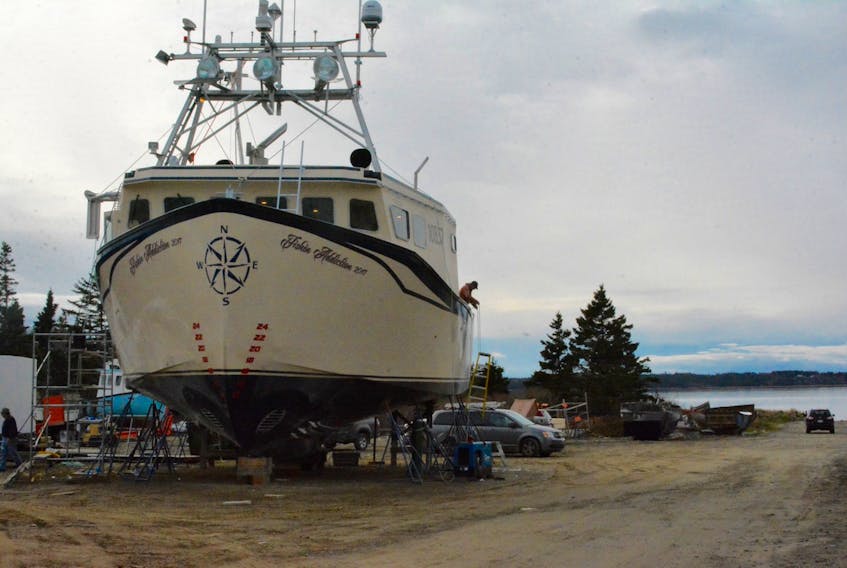WEDGEPORT, YARMOUTH COUNTY, NS – Wedgeport Boats is boosting its production capacity and hiring more employees to meet the strong demand for modern lobster-fishing boats.
Fraser Challoner, the boatyard’s general manager, said in an interview Wedgeport Boats is more than doubling the size of one of its finishing bays, growing it by roughly 3,500 square feet.
“It’ll increase our production capacity by 25 per cent,” said Challoner.
A finishing bay is the area in a boatyard where the empty hull of a ship is equipped with, well, everything. Walls, floors, the engines, doors, windows, and fishing and communications equipment are all added at this stage. The company has also upped the size of the area it has available to park boats on shore while they await repairs or upgrades.
The expansion to the production facility will mean more jobs.
“We employ around 30 and when we open this other bay we could employ another five or six people,” said Challoner.
COMPLEX AND LARGER BOATS
The challenge for Nova Scotia’s boatyards – some industry insiders say the biggest challenge – is finding those employees to build increasingly complex and larger lobster-fishing boats.
“Boatbuilders are looking at replacing wood with some composite panels for deckhouses,” said Tim Edwards, executive director of the Nova Scotia Boatbuilders Association. “Many lobster boats are being fitted with live wells – to help improve the quality of landed catch.
“Because the boats are bigger and more complex than they were even five to eight years ago, they are taking longer to build,” he said. “So, a boatyard that used to build 12 boats a year 10 years ago may only build five a year now with the same number of employees. To increase the number of boats they can build per year, yards have to increase their workforce and facilities.”
The 41-member boatbuilders association has been working hard to encourage high school students to get into the industry and has even helped develop two new apprenticeship programs – the boat builder and marine service technician programs – to do that.
“Young people entering the workforce now have the option of following a structured training and learning plan that, on successful completion, earns them a journeyperson certificate from the Province of Nova Scotia,” said Edwards.
Although boatbuilding is still a largely male-dominated industry, women are making inroads. At Wedgeport, about 20 per cent of the employees are women. At A.F. Theriault & Son, that figure is about seven per cent.
On the sprawling grounds of the A.F. Theriault boatyard off the Evangeline Trail in Meteghan River, managing director Gilles Theriault has grown his workforce by about 9.4 per cent, to 175 employees, in the past year alone. Although lobster-fishing boats only account for less than 15 per cent of that boatyard’s revenues, it’s clear the strong demand from the lobster-fishing industry for bigger and more modern vessels has fuelled growth at A.F. Theriault as well.
Last year, the number of people employed in the boatbuilding sector, which includes builders, repairers and service providers, jumped by 11 per cent over the previous year to hit 1,350.

STEADY GROWTH
That wasn’t a surprise. The industry in Nova Scotia has seen steady growth in employment since 2009 and a boom since mid-2014.
“The lobster fishery is the main economic driver for Nova Scotia’s boatbuilding industry. It has been for the last five years and it will probably be for the next five years,” said Edwards. “The market is good … Nova Scotia lobster is hard to beat.”
At Wedgeport Boats, there are orders for lobster boats for the next two years and some boatyards have a backlog stretching out as much as four years, said Challoner.
“There’s been an increase in the catch. The Chinese market has opened up … Everything came together right (about three years ago),” he said. “The U.S. dollar increased substantially so we had a lot of American lobster fishermen buying the second-hand boats. They were flying out the door.”
Modern lobster fishing is no longer done primarily with the plywood-and-paint boats that plied Nova Scotia’s waters a few generations ago.
“In the lobster-fishing industry, the boats have become quite big,” said Theriault. “The orders to build them are still there but, because the boats are now bigger, it is getting harder to build as many of them …. They are certainly more expensive.”
CHANGES IN INDUSTRY
There are different types of lobster-fishing boats and so each style has changed in different ways. One of them has seen its width increase by 50 per cent to about 30 feet. These boats have bigger engines and are made with new composite materials, which are lighter. They are also equipped with modern electronics and lobster-fishing equipment, bedrooms and showers, and satellite television.
“The newer boats have better systems to keep the landed catch fresher to ensure that what they drop on the wharf is the highest quality,” said Edwards. "The old boats aren’t big enough in many cases (to accommodate the newer equipment) … and the fishermen like to get to their grounds as fast as they can and older boats aren’t as fast.”
The trade-off, though, is the price. As the boats have gotten bigger, more technical and powerful, and equipped with better equipment, their price has also gone up.
A basic lobster-fishing boat in 2004 might have cost $400,000; today, the bigger and better boat that’s the new standard will go for about $900,000, said Challoner.









